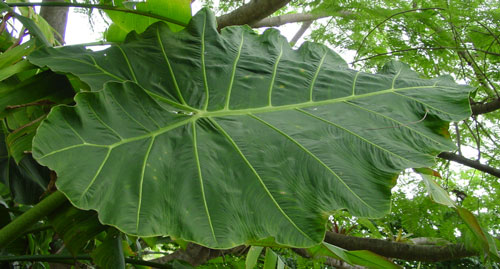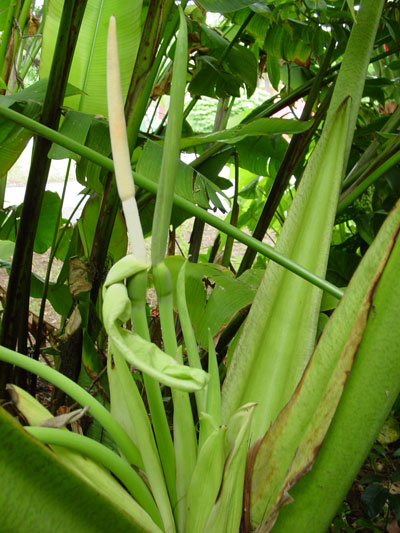
Mystery Alocasia!
The blade of the leaf shown above measured over 5 feet long, and is of very heavy texture, much like Alocasia alba (crassifolia), but far more pronounced. The overall height of the plant we observed was between six and seven feet, and it was mature enough for blooming, as you can see in the subsequent picture. The impression one gets when viewing this plant is that it is like an Alocasia "Sarian" on steroids, bigger and heavier in every way when compared to A. "Sarian", but with petioles more in proportion to the overall size of the plant. Emerging leaves have prominently creamy main veins in the leaf, but the creamy color fades gradually to light green as the leaves age.
We have been told that the plant originated in the Phillippines, is named after a Ms. Vangie Go, of Aglaonema hybridizing fame, and that it is a species, but other than that, we know very little about it. The inflorescences produce copious pollen, which we were able to acquire. This pollen has been used for hybridization at Aroidia Research and we have progeny from three different ovule parents growing on at this time. See our page, Alocasia "Imperial Giant" for an example of this plant crossed with Alocasia macrorrhizos "Borneo Giant".
We would be delighted to know more about this plant, especially if the plant has been described botanically, and what the correct botanical name is for it.

We have learned this summer the the mature plant pictured here has perished. Fortunately, the germ plasm has been preserved in the three hybrids we have produced, all of which are more durable and likely to survive long term. The hybrid involving A. "Borneo Giant" in particular is very similar to the parent type specimen "VangiGo" and will in all likelihood be fertile, enabling quick recovery of the type specimen via F2 work.
| In the Lab | In the Field | The Species | Fruiting | The Hybrids |